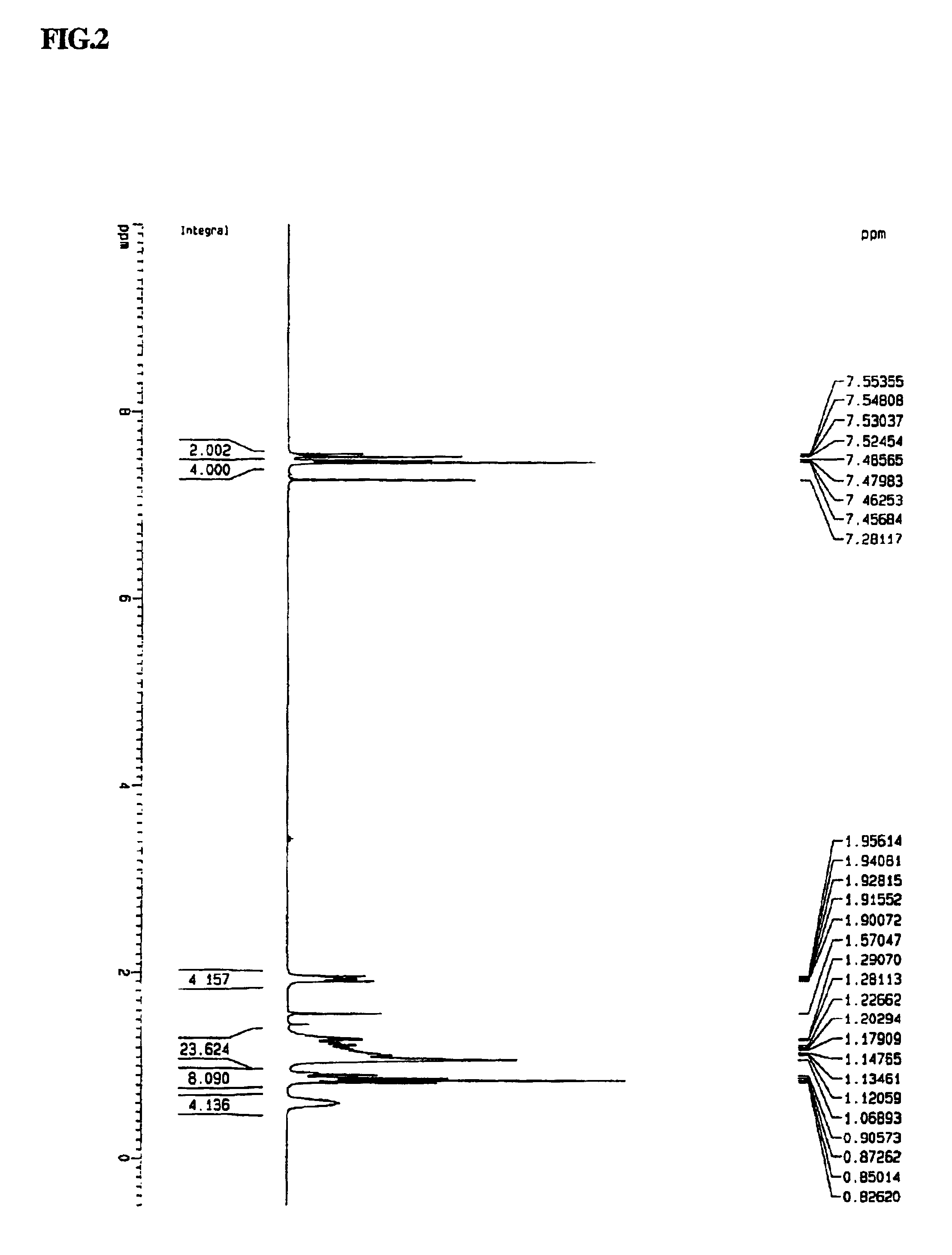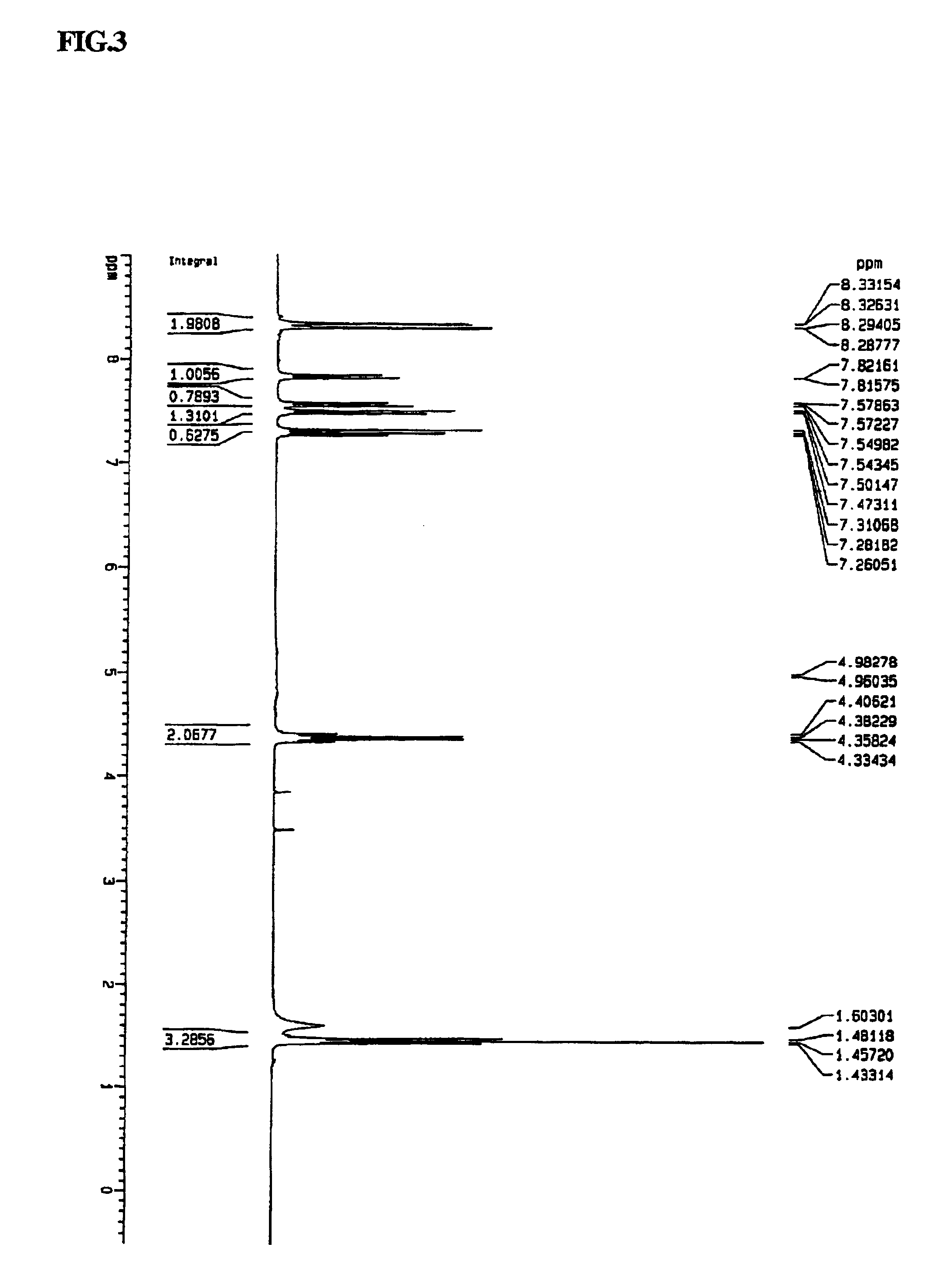White electroluminescent polymer and organic electroluminescent device using the same
- Summary
- Abstract
- Description
- Claims
- Application Information
AI Technical Summary
Benefits of technology
Problems solved by technology
Method used
Image
Examples
example 1
Synthesis of N,N′-diethyl-3,3′-bicarbazyl
[0048]N-ethylcarbazole (20 g (99.35 mmol)) was placed into a 250 ml Schlenk flask and 150 ml of chloroform was added to dissolve the N-ethylcarbazole. Separately, 64.46 g (0.397 mol, 4.0 eq) of FeCl3 was dispersed into 100 ml of chloroform. The dispersion was added to the flask dropwise. At this point, the solution in the flask gradually turned to a dark green color due to the formation of carbazole cation radicals. After 24 hours, the reaction mixture was poured into excess methanol. The precipitated solid was isolated by filtration and continuously washed with excess methanol, and three times with water. After drying, the N,N′-diethyl-3,3′-bicarbazyl was obtained at 95% yield. Its structure was confirmed by 1H-NMR. 1H-NMR (300 MHz, CDCl3): d 1.50 (t, 6H, 2-CH3), 4.45 (quartet, 4H, 2-NCH2), 7.26-8.5 (m, 14H, aromatic protons).
example 2
Synthesis of N,N′-diethyl-6,6′-dibromo-3,3′-bicarbazyl
[0049]N,N′-diethyl-3,3′-bicarbazyl (4 g (10 mmol)) was placed into a 100 ml Schlenk flask, and 50 ml of chloroform was added to dissolve the contents. Separately, 5.0 g (31 mmol, 3.0 eq) of bromine was dissolved in 10 ml of chloroform. The resulting solution was added to the flask dropwise. For this procedure, the temperature of the reaction was maintained at about 0° C. using an ice bath. The solution in the flask gradually turned to dark green color. After 30 to 40 minutes, the reaction mixture was poured into excess water and washed repeatedly with 1.0 N NaOH(aq). The separated chloroform layer was again poured into methanol. The precipitated solids were isolated by filtration and washed repeatedly with excess methanol and water. After drying, the N,N′-diethyl-6,6′-dibromo-3,3′-bicarbazyl was obtained at 90% yield. Its structure was confirmed by 1H-NMR as shown in FIG. 3. 1H-NMR (300 MHz, CDCl3): d 1.46 (t, 6H, 2-CH3), 4.34 (q...
example 3
Synthesis of N-(3-methylphenyl)carbazole
[0050]Activated Cu, (4.2 g (65.8 mmol, 1.1 eq)), 12.4 g (89.7 mmol, 1.5 eq) of K2CO3, 10 g (59.8 mmol) of carbazole, 0.47 g (3 mol %) of 18-crown-6 and 13.7 g (62.8 mmol, 1.05 eq) of 3-iodotoluene were added into 100 ml of dried 1,2-dichlorobenzene and reacted at 180° C. for 24 hours. Then, the reaction mixture was filtered to remove un-reacted Cu and salts. The filtrate was distilled under reduced pressure to remove the solvent and purified by silica gel chromatography. The product was obtained as a colorless liquid at 88.3% (15.5 g) yield. 1H-NMR (300 MHz, CDCl3): δ 8.17 (2H, d), 7.51-7.27 (10H, m), 2.51 (3H, s).
PUM
| Property | Measurement | Unit |
|---|---|---|
| Length | aaaaa | aaaaa |
| Molecular weight | aaaaa | aaaaa |
| Electroluminescence | aaaaa | aaaaa |
Abstract
Description
Claims
Application Information
 Login to View More
Login to View More - R&D
- Intellectual Property
- Life Sciences
- Materials
- Tech Scout
- Unparalleled Data Quality
- Higher Quality Content
- 60% Fewer Hallucinations
Browse by: Latest US Patents, China's latest patents, Technical Efficacy Thesaurus, Application Domain, Technology Topic, Popular Technical Reports.
© 2025 PatSnap. All rights reserved.Legal|Privacy policy|Modern Slavery Act Transparency Statement|Sitemap|About US| Contact US: help@patsnap.com



